maintenance schedule JEEP GRAND CHEROKEE 2008 WK / 3.G Owners Manual
[x] Cancel search | Manufacturer: JEEP, Model Year: 2008, Model line: GRAND CHEROKEE, Model: JEEP GRAND CHEROKEE 2008 WK / 3.GPages: 490, PDF Size: 6.86 MB
Page 1 of 490
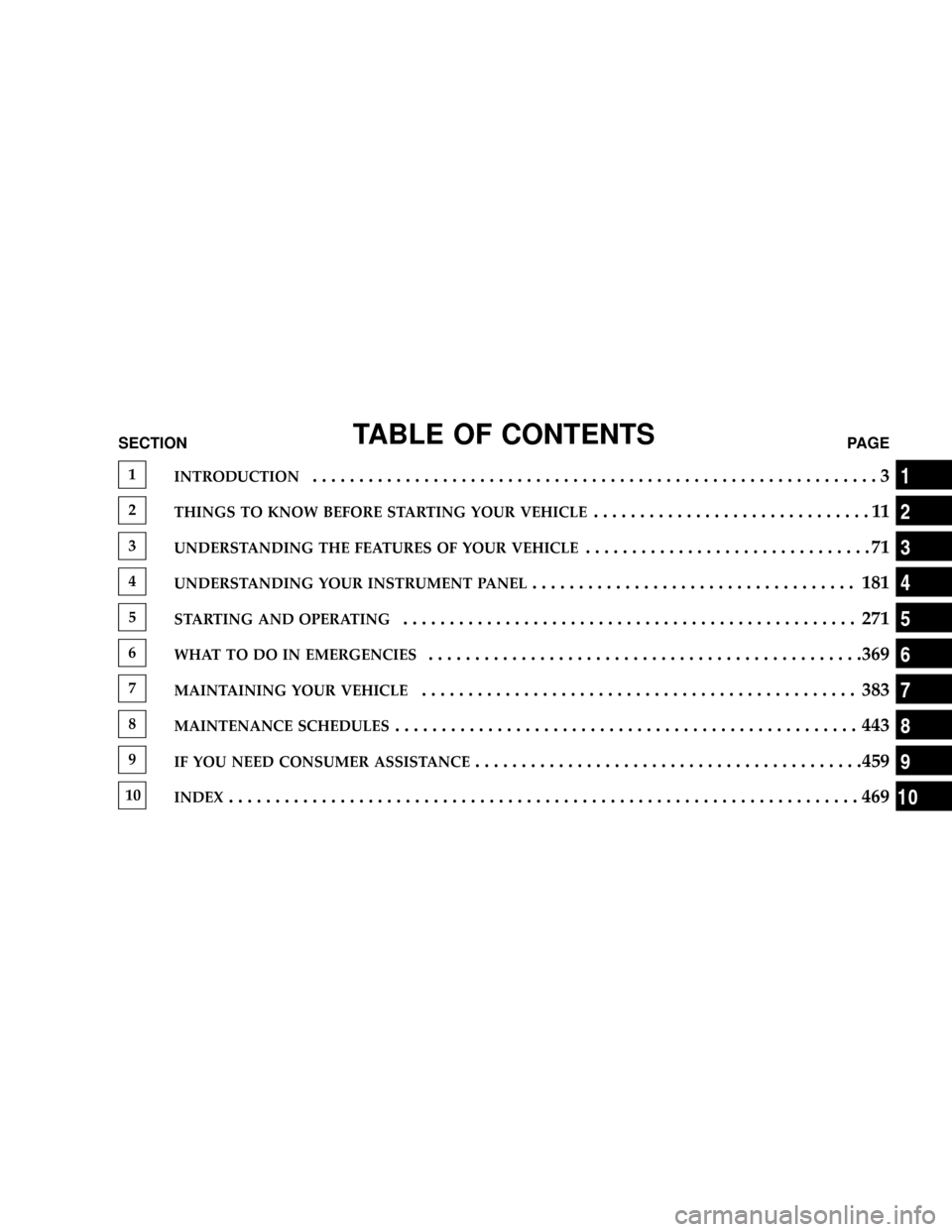
TABLE OF CONTENTSSECTIONPAGE
1INTRODUCTION.............................................................3
2THINGS TO KNOW BEFORE STARTING YOUR VEHICLE..............................11
3UNDERSTANDING THE FEATURES OF YOUR VEHICLE...............................71
4UNDERSTANDING YOUR INSTRUMENT PANEL................................... 181
5STARTING AND OPERATING................................................. 271
6WHAT TO DO IN EMERGENCIES...............................................369
7MAINTAINING YOUR VEHICLE............................................... 383
8MAINTENANCE SCHEDULES.................................................. 443
9IF YOU NEED CONSUMER ASSISTANCE..........................................459
10INDEX....................................................................469
1
2
3
4
5
6
7
8
9
10
Page 201 of 490
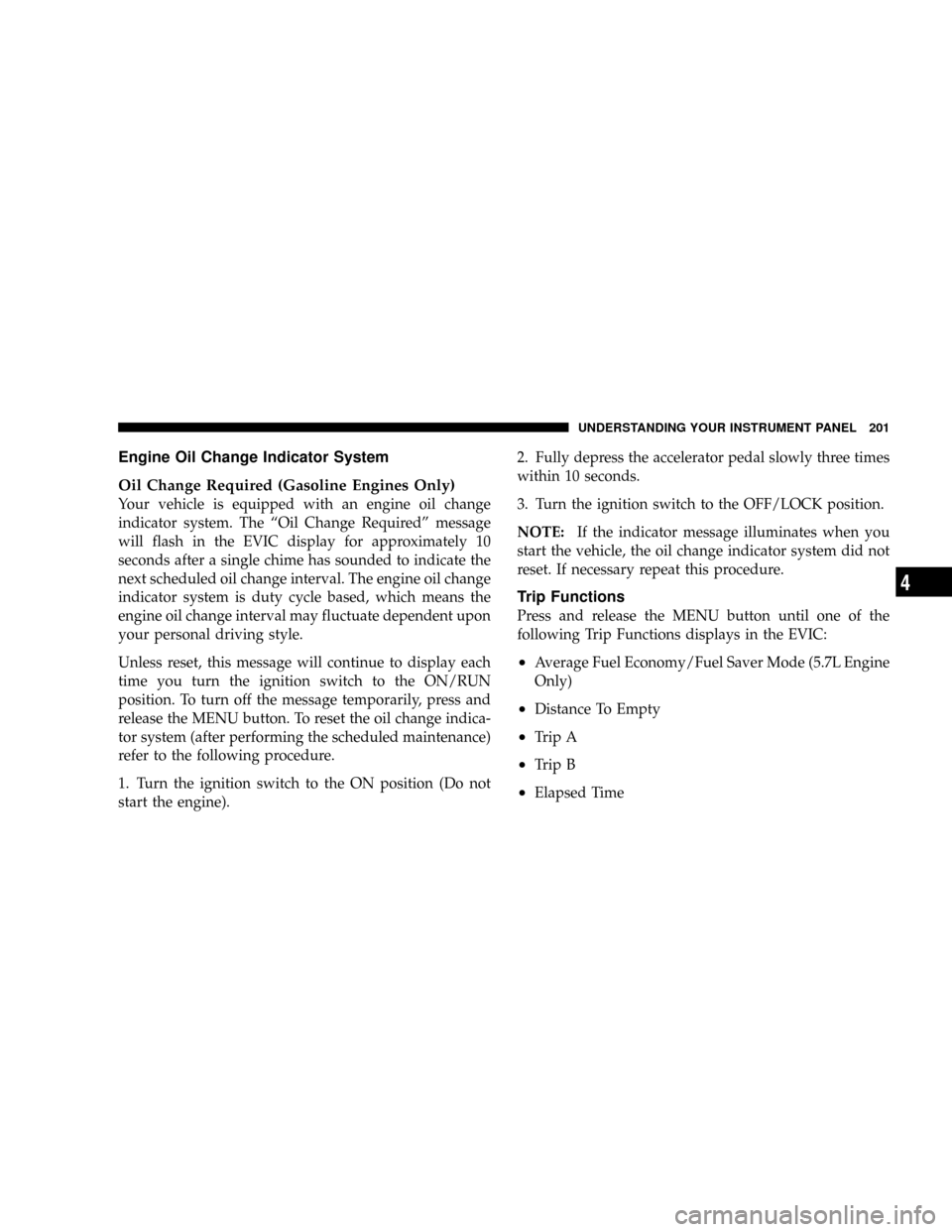
Engine Oil Change Indicator System
Oil Change Required (Gasoline Engines Only)
Your vehicle is equipped with an engine oil change
indicator system. The ªOil Change Requiredº message
will flash in the EVIC display for approximately 10
seconds after a single chime has sounded to indicate the
next scheduled oil change interval. The engine oil change
indicator system is duty cycle based, which means the
engine oil change interval may fluctuate dependent upon
your personal driving style.
Unless reset, this message will continue to display each
time you turn the ignition switch to the ON/RUN
position. To turn off the message temporarily, press and
release the MENU button. To reset the oil change indica-
tor system (after performing the scheduled maintenance)
refer to the following procedure.
1. Turn the ignition switch to the ON position (Do not
start the engine).2. Fully depress the accelerator pedal slowly three times
within 10 seconds.
3. Turn the ignition switch to the OFF/LOCK position.
NOTE:If the indicator message illuminates when you
start the vehicle, the oil change indicator system did not
reset. If necessary repeat this procedure.
Trip Functions
Press and release the MENU button until one of the
following Trip Functions displays in the EVIC:
²Average Fuel Economy/Fuel Saver Mode (5.7L Engine
Only)
²Distance To Empty
²Trip A
²Trip B
²Elapsed Time
UNDERSTANDING YOUR INSTRUMENT PANEL 201
4
Page 326 of 490

Follow the recommended tire rotation frequency for your
type of driving found in the ªMaintenance Schedulesº
Section of this manual. More frequent rotation is permis-
sible if desired. The reasons for any rapid or unusual
wear should be corrected prior to rotation being per-
formed.
NOTE:The Premium Tire Pressure Monitor System will
automatically locate the pressure values displayed in the
correct vehicle position following a tire rotation.
The suggested rotation method is the ªforward-crossº
shown in the following diagram.
TIRE PRESSURE MONITOR SYSTEM (TPMS)
The Tire Pressure Monitoring System (TPMS) will warn
the driver of a low tire pressure based on the vehicle
recommended cold tire pressure.
The tire pressure will vary with temperature by about 1
psi (7 kPa) for every 12ÉF (±11ÉC). This means that when
the outside temperature decreases, the tire pressure will
326 STARTING AND OPERATING
Page 358 of 490
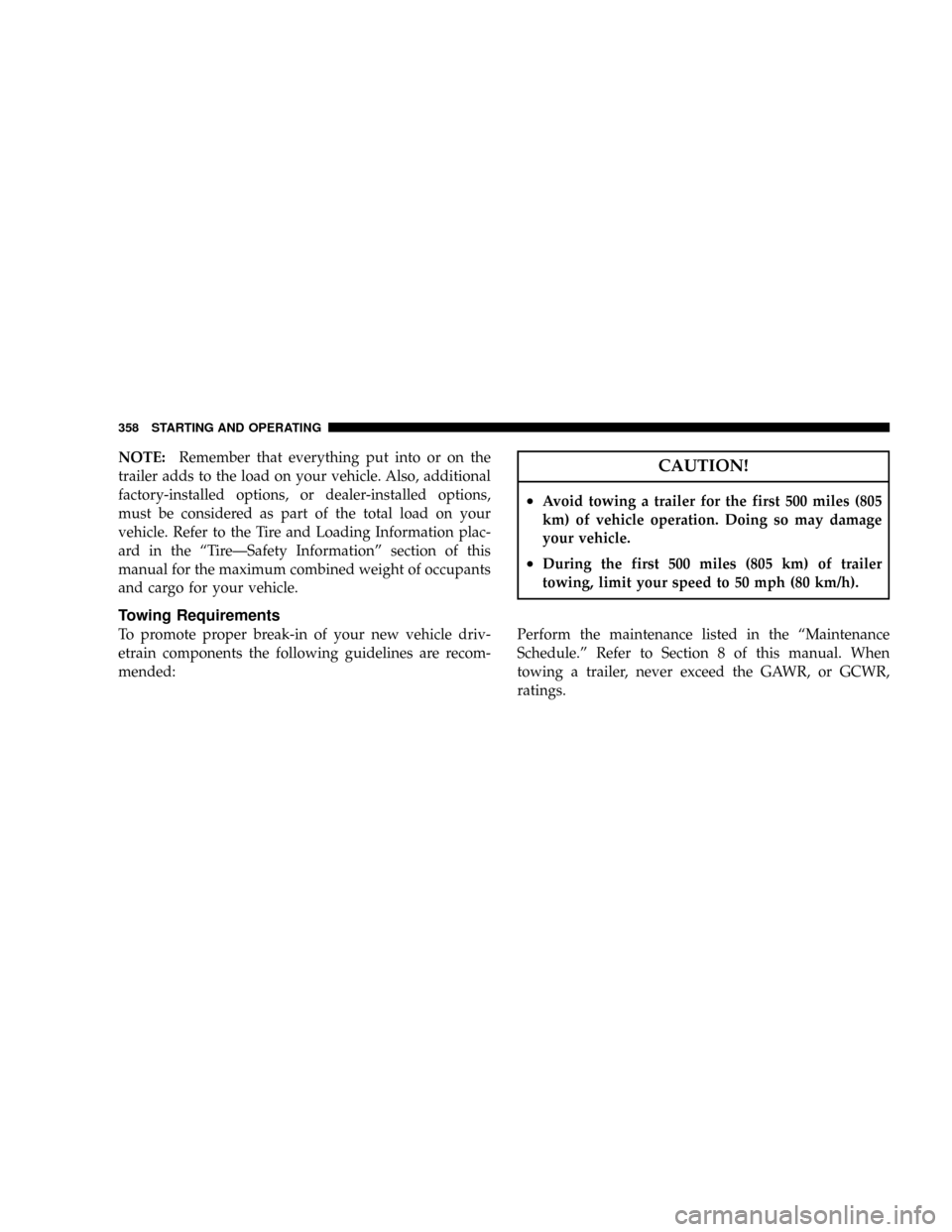
NOTE:Remember that everything put into or on the
trailer adds to the load on your vehicle. Also, additional
factory-installed options, or dealer-installed options,
must be considered as part of the total load on your
vehicle. Refer to the Tire and Loading Information plac-
ard in the ªTireÐSafety Informationº section of this
manual for the maximum combined weight of occupants
and cargo for your vehicle.
Towing Requirements
To promote proper break-in of your new vehicle driv-
etrain components the following guidelines are recom-
mended:
CAUTION!
²Avoid towing a trailer for the first 500 miles (805
km) of vehicle operation. Doing so may damage
your vehicle.
²During the first 500 miles (805 km) of trailer
towing, limit your speed to 50 mph (80 km/h).
Perform the maintenance listed in the ªMaintenance
Schedule.º Refer to Section 8 of this manual. When
towing a trailer, never exceed the GAWR, or GCWR,
ratings.
358 STARTING AND OPERATING
Page 393 of 490
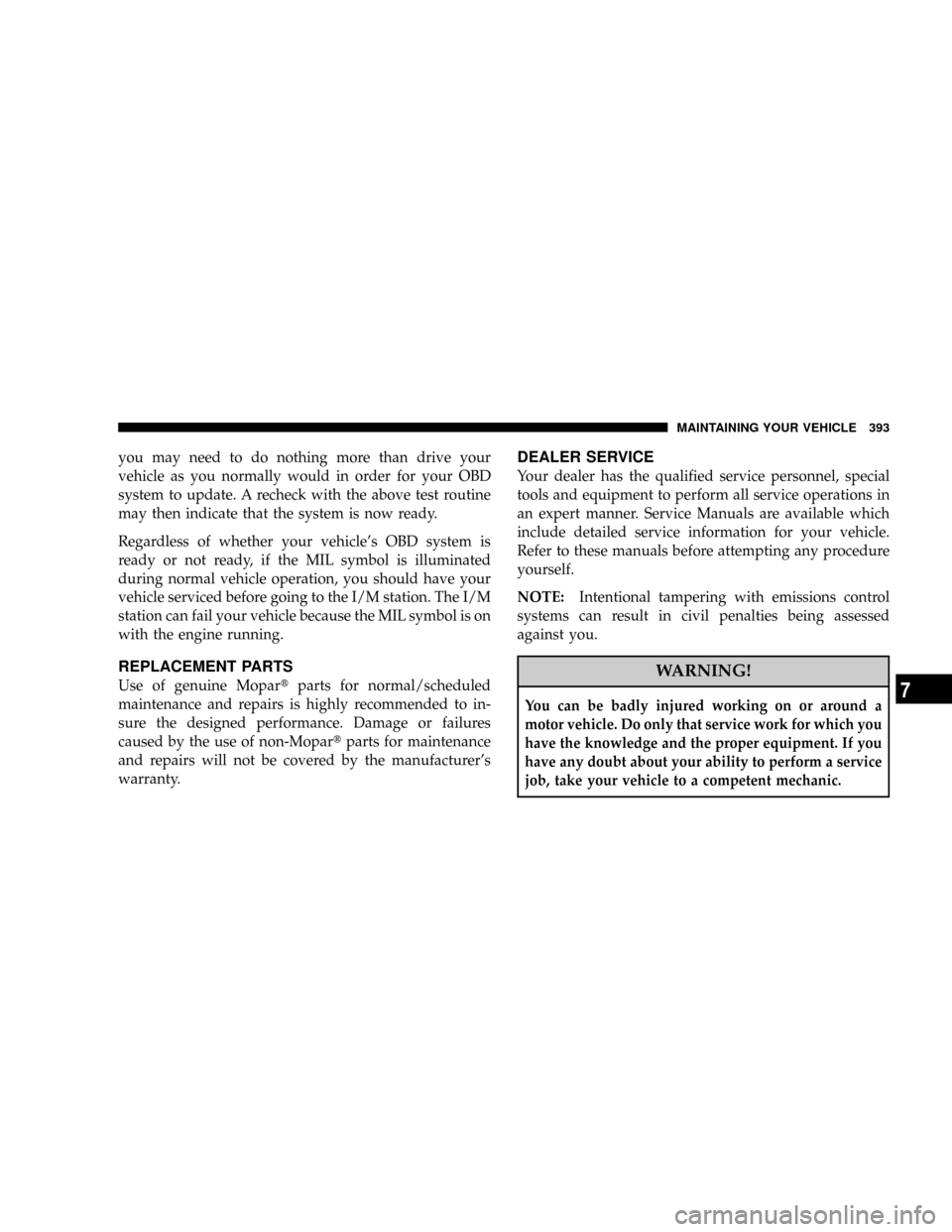
you may need to do nothing more than drive your
vehicle as you normally would in order for your OBD
system to update. A recheck with the above test routine
may then indicate that the system is now ready.
Regardless of whether your vehicle's OBD system is
ready or not ready, if the MIL symbol is illuminated
during normal vehicle operation, you should have your
vehicle serviced before going to the I/M station. The I/M
station can fail your vehicle because the MIL symbol is on
with the engine running.
REPLACEMENT PARTS
Use of genuine Mopartparts for normal/scheduled
maintenance and repairs is highly recommended to in-
sure the designed performance. Damage or failures
caused by the use of non-Mopartparts for maintenance
and repairs will not be covered by the manufacturer's
warranty.
DEALER SERVICE
Your dealer has the qualified service personnel, special
tools and equipment to perform all service operations in
an expert manner. Service Manuals are available which
include detailed service information for your vehicle.
Refer to these manuals before attempting any procedure
yourself.
NOTE:Intentional tampering with emissions control
systems can result in civil penalties being assessed
against you.
WARNING!
You can be badly injured working on or around a
motor vehicle. Do only that service work for which you
have the knowledge and the proper equipment. If you
have any doubt about your ability to perform a service
job, take your vehicle to a competent mechanic.
MAINTAINING YOUR VEHICLE 393
7
Page 395 of 490
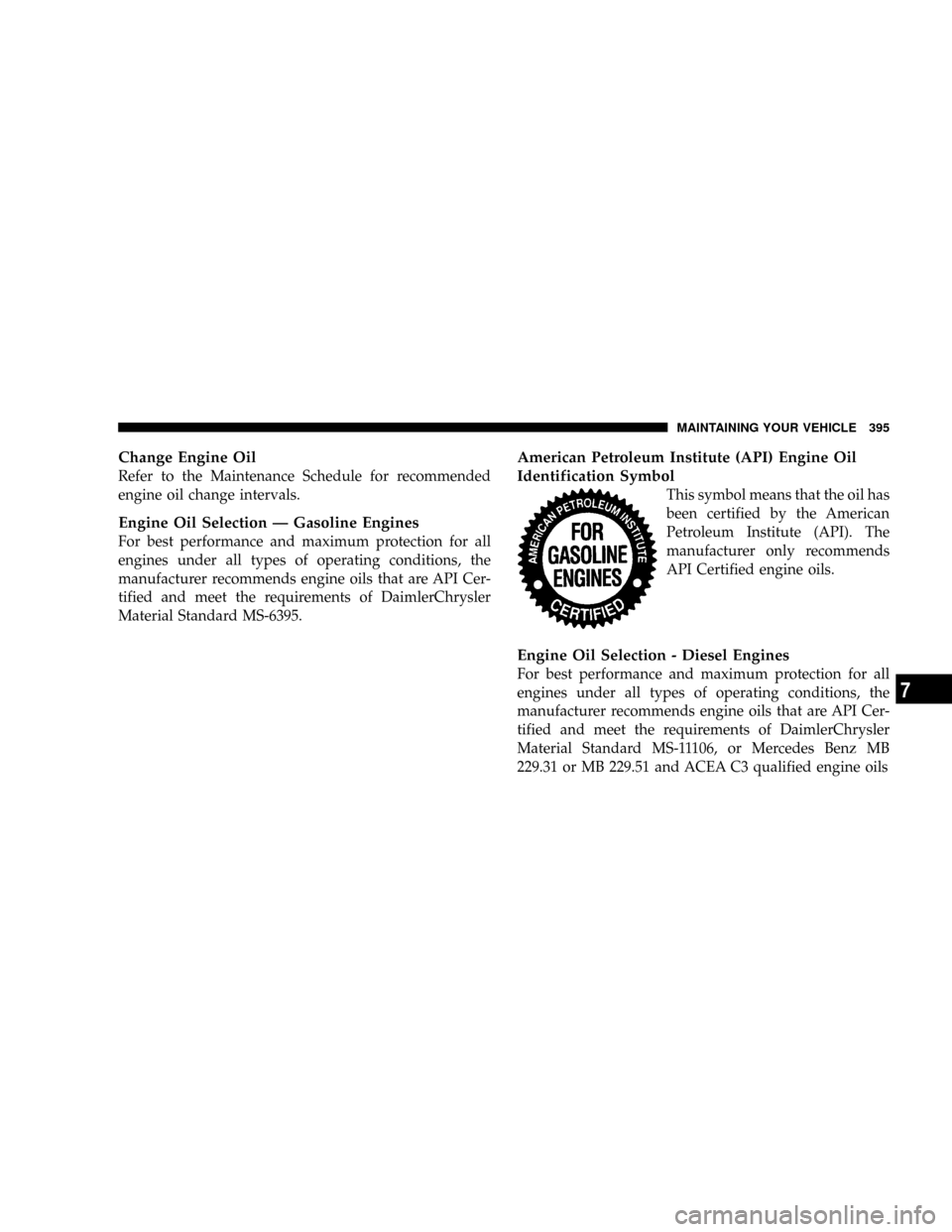
Change Engine Oil
Refer to the Maintenance Schedule for recommended
engine oil change intervals.
Engine Oil Selection Ð Gasoline Engines
For best performance and maximum protection for all
engines under all types of operating conditions, the
manufacturer recommends engine oils that are API Cer-
tified and meet the requirements of DaimlerChrysler
Material Standard MS-6395.
American Petroleum Institute (API) Engine Oil
Identification Symbol
This symbol means that the oil has
been certified by the American
Petroleum Institute (API). The
manufacturer only recommends
API Certified engine oils.
Engine Oil Selection - Diesel Engines
For best performance and maximum protection for all
engines under all types of operating conditions, the
manufacturer recommends engine oils that are API Cer-
tified and meet the requirements of DaimlerChrysler
Material Standard MS-11106, or Mercedes Benz MB
229.31 or MB 229.51 and ACEA C3 qualified engine oils
MAINTAINING YOUR VEHICLE 395
7
Page 398 of 490

Drive Belts Ð Check Condition and Tension
Belt tension is controlled by means of an automatic
tensioner. No belt tension adjustments are required.
However, belt and belt tensioner condition should be
inspected at the specified intervals, and replaced if re-
quired. See your authorized dealer for service.
At the mileage indicated in the maintenance schedule, all
belts and tensioner should be checked for condition.
Improper belt tension can cause belt slippage and failure.
Belts should be inspected for evidence of cuts, cracks,
glazing, or frayed cords and replaced if there is indication
of damage which could result in belt failure. Low gen-
erator belt tension can cause battery failure.
Also, check belt routing to make sure there is no inter-
ference between the belts and other engine components.
Spark Plugs
Spark plugs must fire properly to assure engine perfor-
mance and emission control. New spark plugs should be
installed at the specified mileage. The entire set should be
replaced if there is any malfunction due to a faulty spark
plug. Refer to ªFluids, Lubricants, and Genuine Partsº in
this section for spark plug information.
Spark Plug Wires
The spark plug wires should be kept clean and properly
connected. Terminals should be fully seated. Cracked,
damaged, or faulty wires should be replaced.
Engine Air Cleaner Filter
Refer to the Maintenance Schedule for recommended
Engine Air Cleaner Filter change intervals.
398 MAINTAINING YOUR VEHICLE
Page 408 of 490
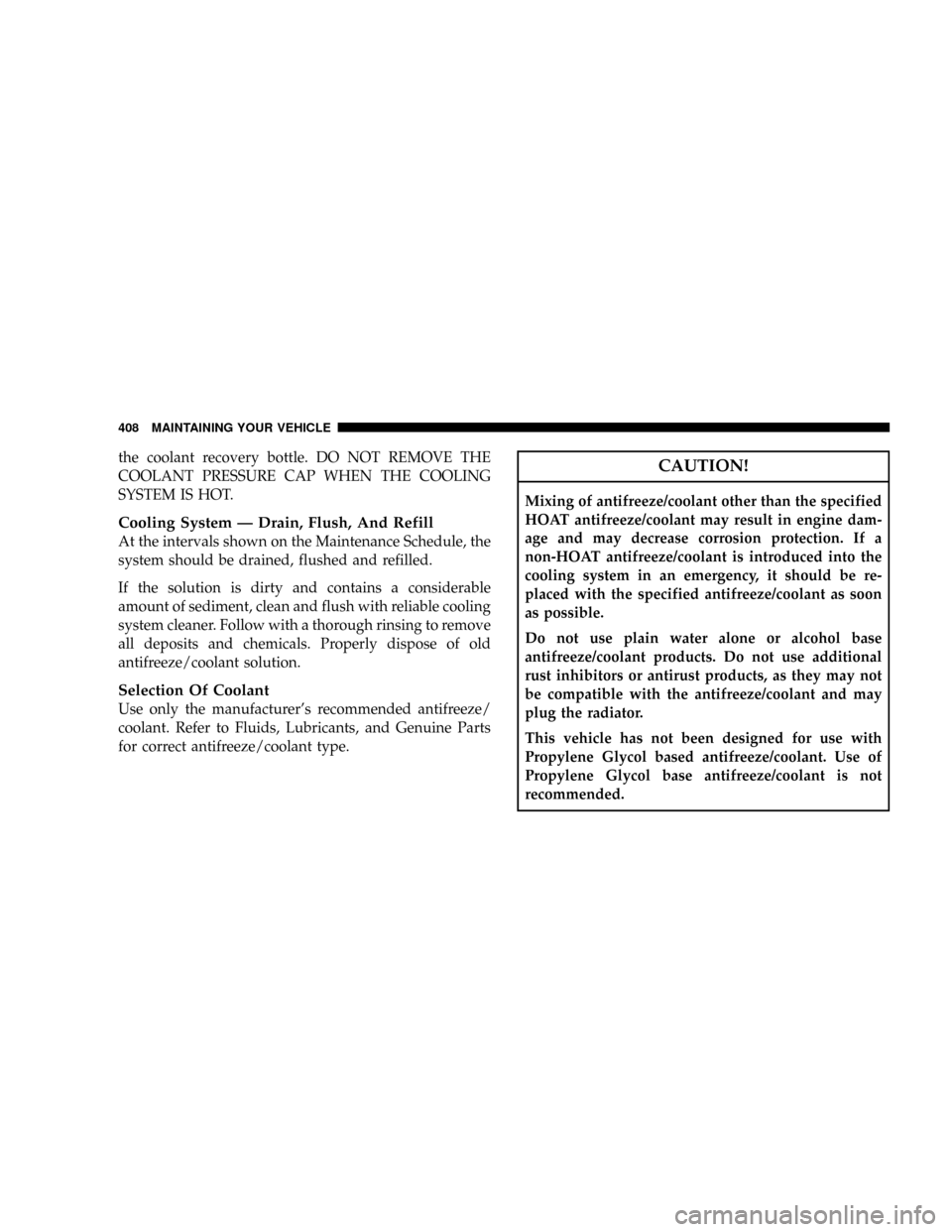
the coolant recovery bottle. DO NOT REMOVE THE
COOLANT PRESSURE CAP WHEN THE COOLING
SYSTEM IS HOT.
Cooling System Ð Drain, Flush, And Refill
At the intervals shown on the Maintenance Schedule, the
system should be drained, flushed and refilled.
If the solution is dirty and contains a considerable
amount of sediment, clean and flush with reliable cooling
system cleaner. Follow with a thorough rinsing to remove
all deposits and chemicals. Properly dispose of old
antifreeze/coolant solution.
Selection Of Coolant
Use only the manufacturer's recommended antifreeze/
coolant. Refer to Fluids, Lubricants, and Genuine Parts
for correct antifreeze/coolant type.
CAUTION!
Mixing of antifreeze/coolant other than the specified
HOAT antifreeze/coolant may result in engine dam-
age and may decrease corrosion protection. If a
non-HOAT antifreeze/coolant is introduced into the
cooling system in an emergency, it should be re-
placed with the specified antifreeze/coolant as soon
as possible.
Do not use plain water alone or alcohol base
antifreeze/coolant products. Do not use additional
rust inhibitors or antirust products, as they may not
be compatible with the antifreeze/coolant and may
plug the radiator.
This vehicle has not been designed for use with
Propylene Glycol based antifreeze/coolant. Use of
Propylene Glycol base antifreeze/coolant is not
recommended.
408 MAINTAINING YOUR VEHICLE
Page 413 of 490
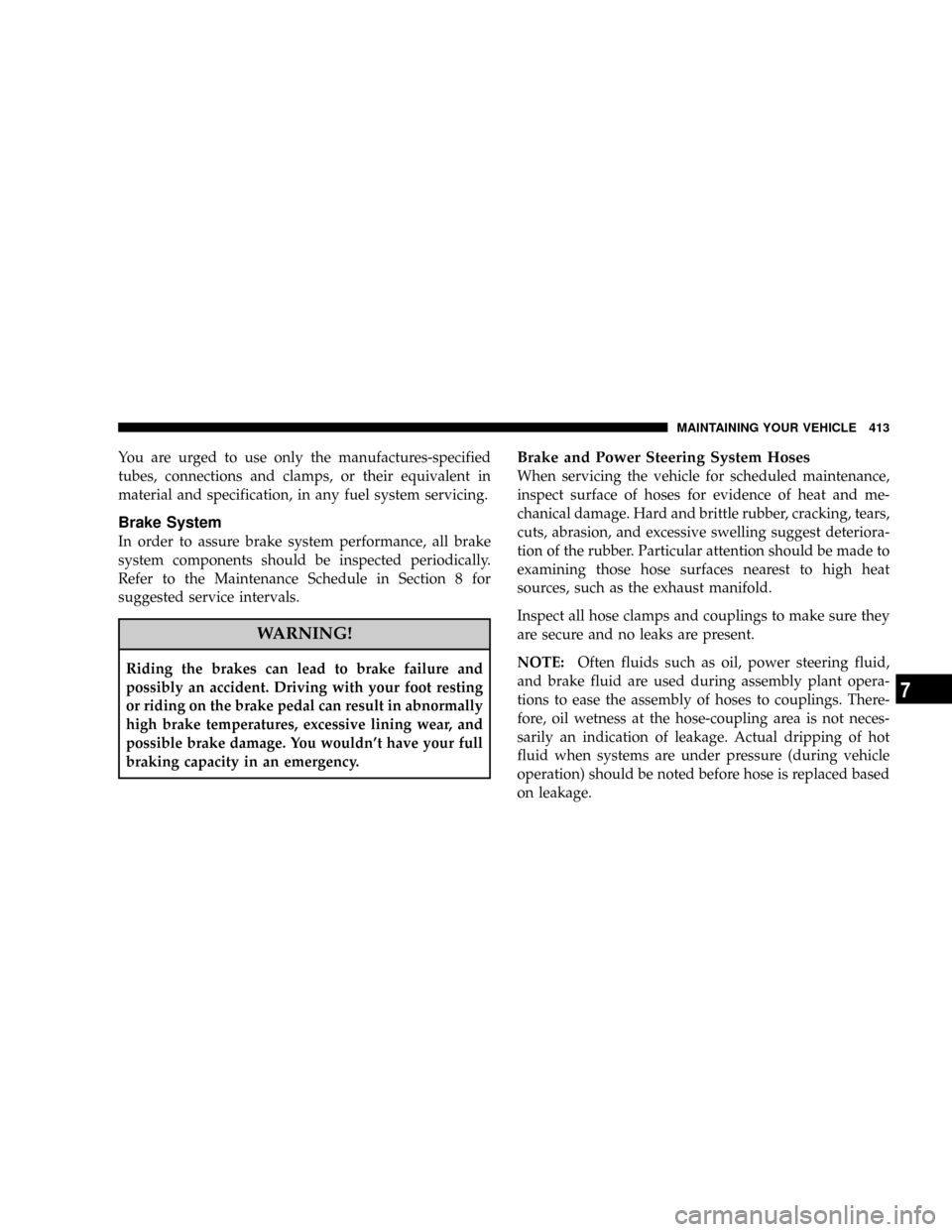
You are urged to use only the manufactures-specified
tubes, connections and clamps, or their equivalent in
material and specification, in any fuel system servicing.
Brake System
In order to assure brake system performance, all brake
system components should be inspected periodically.
Refer to the Maintenance Schedule in Section 8 for
suggested service intervals.
WARNING!
Riding the brakes can lead to brake failure and
possibly an accident. Driving with your foot resting
or riding on the brake pedal can result in abnormally
high brake temperatures, excessive lining wear, and
possible brake damage. You wouldn't have your full
braking capacity in an emergency.
Brake and Power Steering System Hoses
When servicing the vehicle for scheduled maintenance,
inspect surface of hoses for evidence of heat and me-
chanical damage. Hard and brittle rubber, cracking, tears,
cuts, abrasion, and excessive swelling suggest deteriora-
tion of the rubber. Particular attention should be made to
examining those hose surfaces nearest to high heat
sources, such as the exhaust manifold.
Inspect all hose clamps and couplings to make sure they
are secure and no leaks are present.
NOTE:Often fluids such as oil, power steering fluid,
and brake fluid are used during assembly plant opera-
tions to ease the assembly of hoses to couplings. There-
fore, oil wetness at the hose-coupling area is not neces-
sarily an indication of leakage. Actual dripping of hot
fluid when systems are under pressure (during vehicle
operation) should be noted before hose is replaced based
on leakage.
MAINTAINING YOUR VEHICLE 413
7
Page 443 of 490
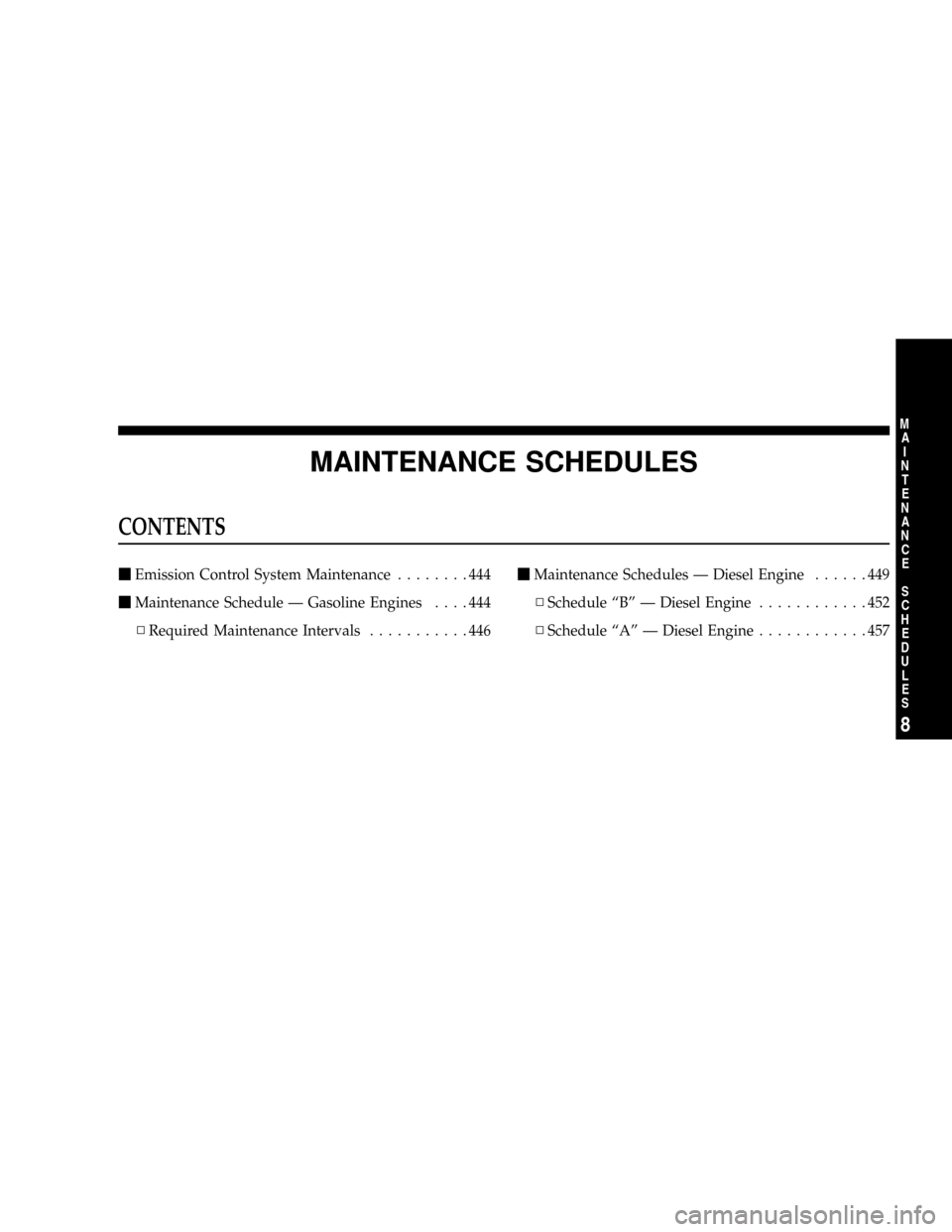
MAINTENANCE SCHEDULES
CONTENTS
mEmission Control System Maintenance........444
mMaintenance Schedule Ð Gasoline Engines....444
NRequired Maintenance Intervals...........446mMaintenance Schedules Ð Diesel Engine......449
NSchedule ªBº Ð Diesel Engine............452
NSchedule ªAº Ð Diesel Engine............457
8
M
A
I
N
T
E
N
A
N
C
E
S
C
H
E
D
U
L
E
S